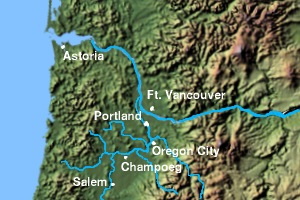Fort Vancouver
|
|
Fort Vancouver was a 19th century fur trading outpost along the Columbia River that served as the headquarters of the Hudson's Bay Company in the Oregon Country. Named for Captain George Vancouver, the fort was located on the northern bank of the Columbia River in present-day Vancouver, Washington, near Portland, Oregon.
History
The outpost was established in 1825, at a time when the Oregon Country was jointly administered by the United States and Britain, a situation to which the two nations had agreed in the Anglo-American Convention of 1818. But it was rumored that the border may be set at the Columbia River. This prompted the establishment of Fort George (now Astoria, Oregon), an American fort on the south bank near the mouth of the Columbia. At this time, the Hudson's Bay Company controlled most of the land that is now Canada. Wanting to protect their interests north of the Columbia, the they sent Dr. John McLoughlin to setup the headquarters somewhere along the northern bank that would secure the area and act as the hub for their fur trading in the Pacific Northwest.
McLoughlin, who later would be hailed as the Father of Oregon, was the fort's first administrator. He was responsible for finding a location and overseeing the construction. The site he selected was up river from the American outpost, close to the mouth of the Willamette River, though on the opposing bank. The area was flat and had easy access to the Columbia, yet just outside the flood plain. The site was also picked because of the access to fertile farmland. The Hudson's Bay Company wanted the fort to be self-sufficient, as food was costly to ship. A nice side effect to this location was its immense beauty. The area was commonly known as La Jolie Prairie (the pretty prairie) or Belle Vue Point.
The stockade that protected the fort was 750 feet long, 450 feet wide and about 20 feet high. Inside there was a total of 40 buildings, which were used for housing, warehouses, a school, a library, a pharmacy, a chapel, a blacksmith, and a large manufacturing facility. Outside the ramparts there was additional housing as well as fields, gardens, fruit orchards, a shipyard, a distillery, a tannery, a sawmill, and a dairy. Fort Vancouver was by far the largest western settlement of its time. The populace of the fort and the surrounding area, known as Kanaka Village, were mostly Canadians, there were also English, Irish, French, Hawaiians and a large variety of Indians. The common language spoken at the fort was Canadian French; however, trading was done in Chinook Jargon, a hodge-podge of Chinook, English, French, and Hawaiian.
The fort quickly became the center of activity in the Pacific Northwest. Every year ships would come from London (via the Pacific) to drop off supplies and trade goods in exchange for the furs. It was the nexus for the fur trade on the Pacific Coast, whose influence reached from Alaska to California and from the Rocky Mountains to the Hawaiian Islands. At its pinnacle Fort Vancouver watched over 34 outposts, 24 ports, six ships, and 600 employees. Also, for many settlers the fort became the last stop on the Oregon Trail as they could get supplies and buy land before starting their homestead.
In 1845, McLoughlin left the Hudson's Bay Company for a homestead of his own, and founded Oregon City in the Willamette Valley. In 1846 the Oregon Treaty set the US / Canadian border at the 49th parallel, the fort found itself within American territory. The treaty insured that the Hudson's Bay Company could continue to operate and had free access to navigate the Strait of Juan de Fuca, Puget Sound, and the Columbia. But in 1849 the US Army setup the Columbia Barracks (later renamed the Vancouver Barracks) a few miles away from Fort Vancouver, which prompted the Hudson's Bay Company to move their headquarters to Fort Victoria (now Victoria, British Columbia).
While the company continued to operate out of Fort Vancouver, every year saw less and less fur trade and more and more settlers and US Army movements. Through this time the fort saw the Indian Wars in the west and famous military men such as Ulysses S. Grant and Philip Henry Sheridan. Finally, in 1860, the Hudson's Bay Company abandoned Fort Vancouver and moved their operations north of the border. The US Army used it for quarter and storage until 1866 when most of the fort burned down in a large fire.
Because of the its significance in United States history Fort Vancouver was declared a U.S. National Monument on June 19, 1948 and a U.S. National Historic Site on June 30, 1961. This was take a step further in 1996 when a 366 acre (1.5 km²) area around the fort, which includes Kanaka Village, the Columbia Barracks and the bank of the river, was established as the Vancouver National Historic Reserve and is maintained by the National Park Service. It is possible to tour the fort and it is also the site of a large fireworks display, said to be the largest west of the Mississippi River, on the 4th of July.
External Links
- Fort Vancouver National Historic Site (http://www.nps.gov/fova)

